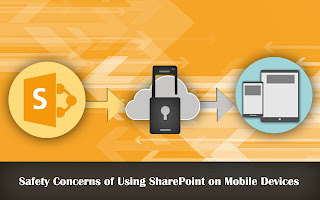The
growing popularity of smartphones and tablets has encouraged many
companies to upgrade their existing software by including specialized
features and functionality to target the new users. Microsoft has
upgraded SharePoint with loads of features to target some of the most
popular mobile operating systems including Windows, iOS and Android.
The mobile capabilities have made it easier for many application
developers and resellers to optimize their users’ mobile experience
without putting any extra time.
At
the same time, these features have enabled users to access a variety
of content on their mobile devices anytime and anywhere. Most
companies, nowadays, allow their staff to access corporate resources
through their mobile devices to reduce project cost. With more and
more users accessing SharePoint 2013 on their handheld devices, it
has become essential for companies to keep the mobile experience of
their employees and customers safe and secure.
So
the IT department often finds it a daunting challenge to completely
control the way the corporate resources are being accessed by various
stakeholders. Many companies even look for the best techniques to
prepare a comprehensive SharePoint mobile security plan. However, you
can always concentrate on some common mobile security measures to
ensure that your employees and clients will access SharePoint content
without compromising the security of sensitive corporate content.
This can help you unleash the powers of custom
sharepoint development
while keeping security strengthened.
5
Common Security Guidelines for Using SharePoint on Mobile Devices
Securing
Content when the Mobile Device is Lost or Stolen: In comparison
to computers, the chances of a mobile device being lost or stolen
are much higher. So you must make a policy to protect the sensitive
documents and data of your company, in case a user’s mobile device
is lost or stolen. If a person is allowed of access corporate
resources on his smartphone or tablet, he must be asked to protect
his mobile devices through a lock or pin. Also, you must explore
options to remotely wipe out the documents and data stored on the
mobile device. As the security features vary from one mobile device
to another, you must implement policies by targeting the major
mobile operating systems.
Protecting
Users’ Login Credentials: Most mobile devices allow users to
store their username, password, and similar credentials. Some
devices even use cookies to store the login credential of users. So
you must train your staff about the most effective way to protect
their credentials. After completing a task, the user must sign out
of the corporate website. Similarly, they must disable all options
that allow them to remember their passwords or keep them signed in.
It is also important to delete cookies on their mobile browser on a
daily basis. These measures will make it difficult for unauthorized
users to access the corporate resources in case the mobile device is
lost or stolen.
Protecting
Communication between Server and Mobile Device: Most users
access the data and documents of their organization through their
mobile web browsers. So you must implement a strategy to secure the
communication between your SharePoint Server 2013 and mobile web
browsers. You can always keep the communication secure by enabling
SSL. You can even consider using Forefront Unified Access Gateway
(UAG) or any other reverse proxy server to keep the communication
secure. By securing the communication, you can further minimize the
chances of your corporate resources being hacked.
Activate
Exchange ActiveSync Protocol: As a communication protocol,
Microsoft Exchange ActiveSync is effective in optimizing the
device-side security. The protocol is presently available for
Windows phones and other third-party mobile devices. You can further
administer the device security by administering a comprehensive
policy. Normally, the mobile devices of users access the SharePoint
Server 2013 through a public-facing URL. So the SharePoint data and
documents will remain inaccessible in case a mobile device is lost
or stolen. Also, you can use the protocol to remotely wipe a variety
of data from the mobile device. The protocol also enables you to
prevent unauthorized access by displaying a lock screen that will
force the users to enter a complex password.
Impose
Multiple Authentications: Microsoft has further updated
SharePoint 2013 with multiple authentication modes and methods.
However, all authentication methods and modes may not be supported
by each mobile device. So you have to make a comprehensive list of
mobile devices that your employees use for accessing the corporate
resources. Based on the supported mobile devices, you have to
understand and implement the relevant authentication modes. Also,
you have to decide the files, documents and resources that you will
allow your staff to access on mobile devices. If you have made
SharePoint sites, it will be easier to decide the mobile devices
that can be used to access the resources externally. The external
access restrictions will also have a impact on the authentication
methods selected by you.
It
is also important to review the guidelines for using SharePoint on
mobile devices to make the security arrangements stronger and more
effective. At the same time, you should also explore the latest
security measures recommended by Microsoft to keep your corporate
resources secure and inaccessible.
We
provide Sharepoint
development services. If you would like to know what makes us
expert SharePoint
developers, please contact us at Mindfire Solutions.
